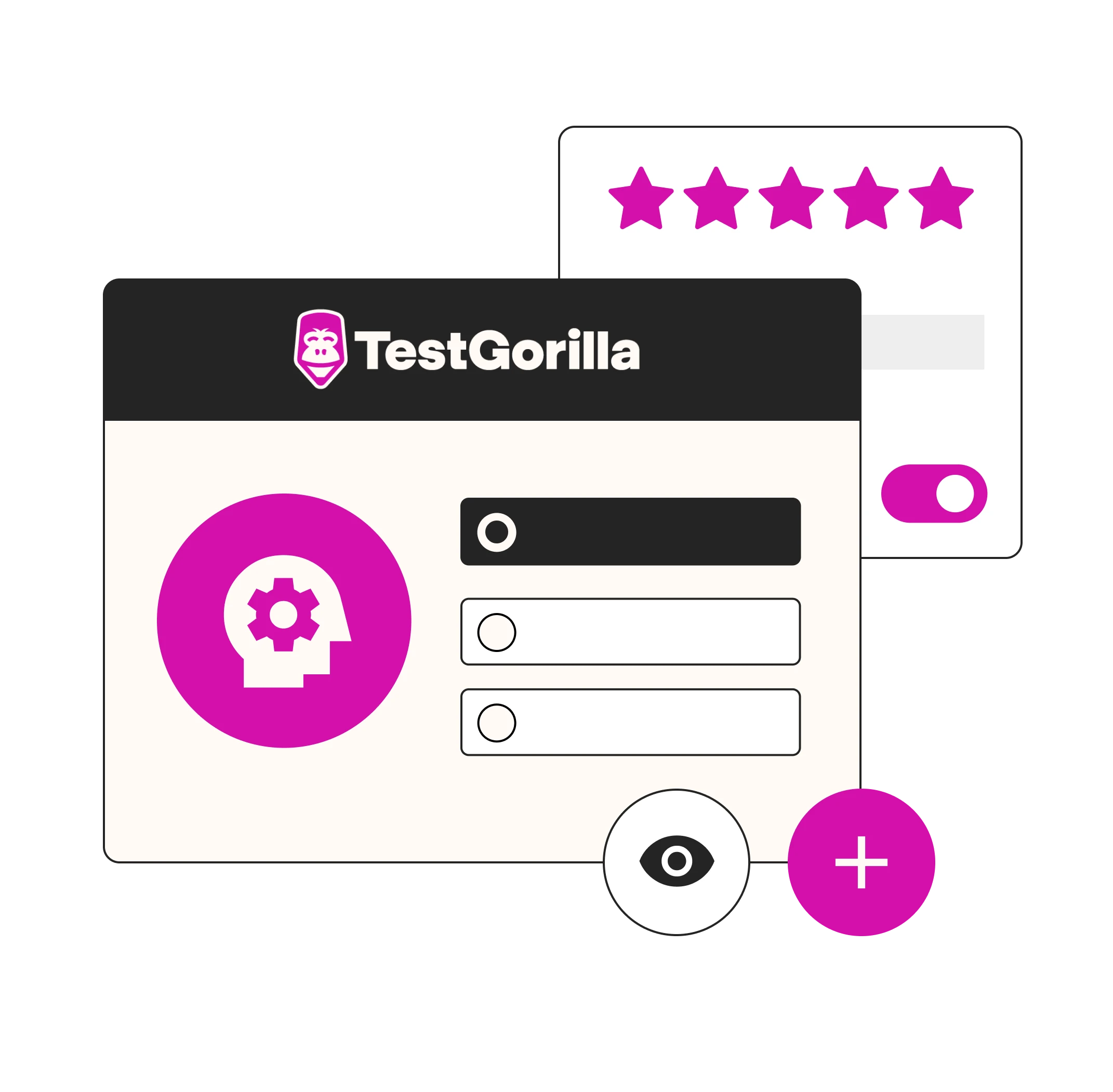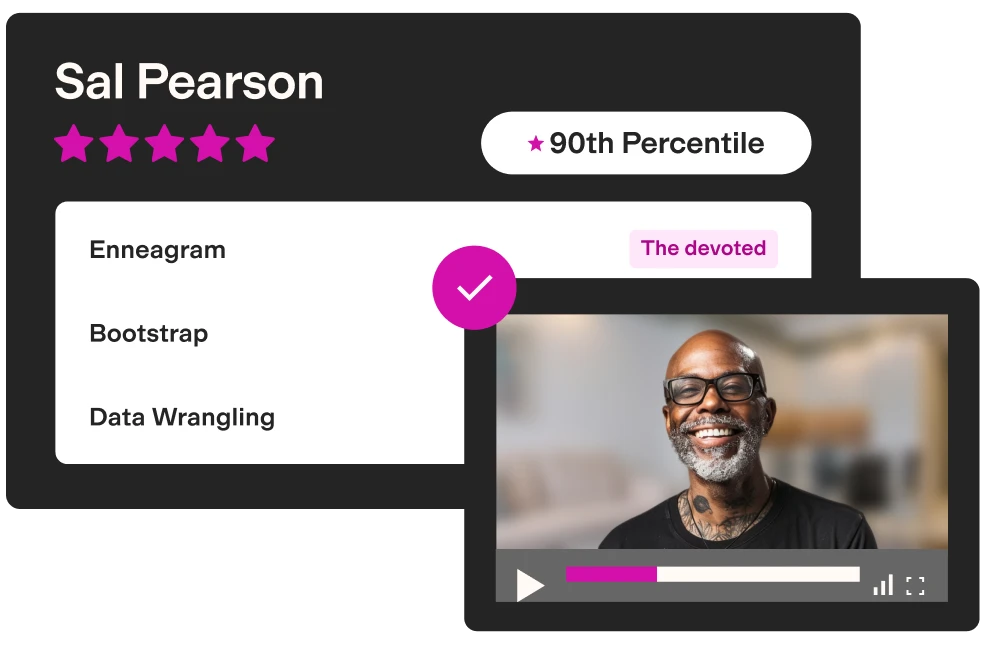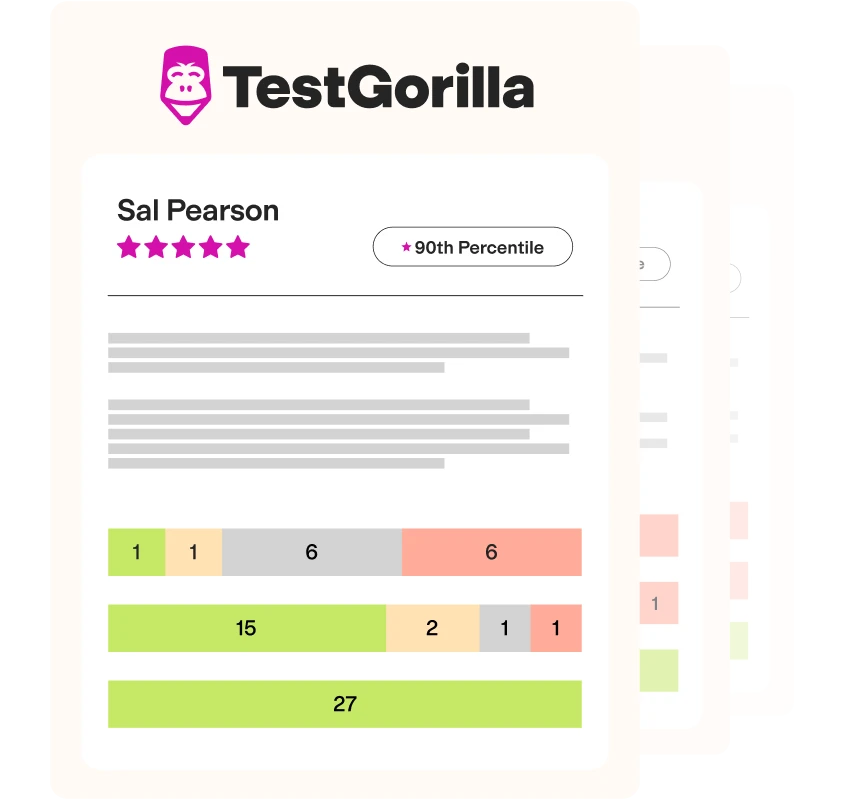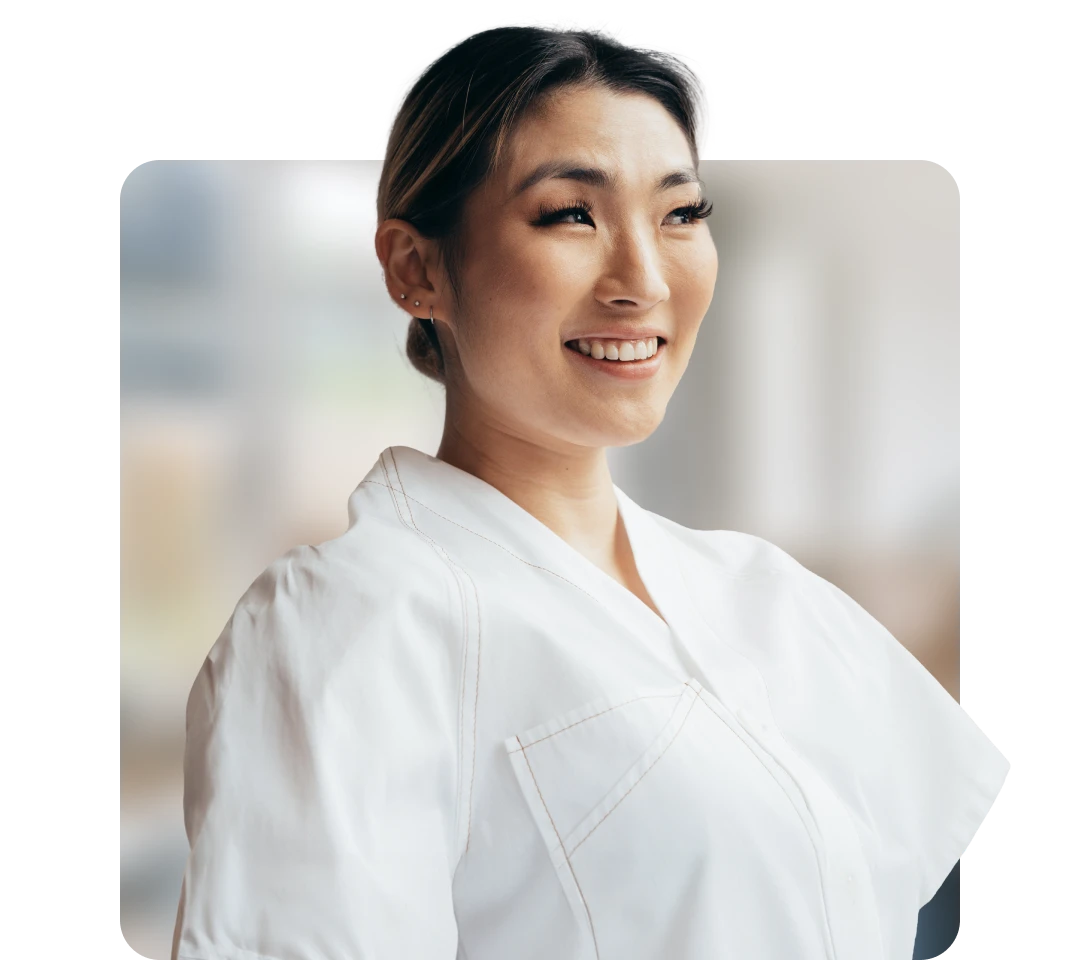Attention to Detail (Visual) test
Summary of the Attention to Detail (Visual) test
This Attention to Detail (Visual) test evaluates candidates’ ability to pay attention to visual details and information. This online skills assessment helps you identify candidates who can pay close attention to visual cues and can handle visual material carefully and thoroughly.
The attention to detail test is designed by a subject matter expert to screen candidates who can find differences in images and match identical images. It also assesses candidates’ ability to distinguish small details in an image and to identify patterns. You can send this online attention-to-detail (visual) assessment to your prospective job applicants and screen them objectively before inviting them to an interview.
Covered skills
Finding differences in images
Matching identical images
Distinguishing design details
Identifying patterns
Use the Attention to Detail (Visual) test to hire
Graphic designers, web designers, visual designers, marketing designers, infographic designers, in-house designers, lab technicians, manufacturing workers, and any other role that requires good attention to visual detail.
About the Attention to Detail (Visual) test
Visual information is everywhere--from the apps and software you use (or create) every day to your organization’s branding and marketing material. Paying attention to detail and catching visual errors isn’t just a nice to have but a necessary skill for any modern organization that uses visual information to attract customers and interact with them, online or in a brick-and-mortar store.
This attention to visual detail test evaluates candidates’ ability to find differences in images and match identical images. It also assesses candidates’ ability to distinguish small details in an image and to identify patterns. Candidates who perform well on this test can process visual information well. They catch minor errors and perceive small details that can have a significant impact. They carefully study details and consider all visual information presented to them.
For a similar test that uses words and textual elements to assess candidates' skills, check out our Attention to Detail (Textual) test.
The test is made by a subject-matter expert
Stella S.
Web and graphic designer Stella knows how to harness the power of design. Fifteen years in the business have built her reputation for helping companies shatter their marketing goals through highly converting websites with stunning graphics.
With a master’s in graphic design, Stella excels in print, web, and marketing design. Her past projects include website creation and management for an online college, university-level web design instruction, and art direction of an international exhibition.
Crafted with expert knowledge
TestGorilla’s tests are created by subject matter experts. We assess potential subject-matter experts based on their knowledge, ability, and reputation. Before being published, each test is peer-reviewed by another expert, then calibrated using hundreds of test takers with relevant experience in the subject.
Our feedback mechanisms and unique algorithms allow our subject-matter experts to constantly improve their tests.
What our customers are saying
TestGorilla helps me to assess engineers rapidly. Creating assessments for different positions is easy due to pre-existing templates. You can create an assessment in less than 2 minutes. The interface is intuitive and it’s easy to visualize results per assessment.
VP of engineering, mid-market (51-1000 FTE)
Any tool can have functions—bells and whistles. Not every tool comes armed with staff passionate about making the user experience positive.
The TestGorilla team only offers useful insights to user challenges, they engage in conversation.
For instance, I recently asked a question about a Python test I intended to implement. Instead of receiving “oh, that test would work perfectly for your solution,” or, “at this time we’re thinking about implementing a solution that may or may not…” I received a direct and straightforward answer with additional thoughts to help shape the solution.
I hope that TestGorilla realizes the value proposition in their work is not only the platform but the type of support that’s provided.
For a bit of context—I am a diversity recruiter trying to create a platform that removes bias from the hiring process and encourages the discovery of new and unseen talent.
Chief Talent Connector, small business (50 or fewer FTE)
Use TestGorilla to hire the best faster, easier and bias-free
Our screening tests identify the best candidates and make your hiring decisions faster, easier, and bias-free.
Watch what TestGorilla can do for you
Create high-quality assessments, fast
Building assessments is a breeze with TestGorilla. Get started with these simple steps.
View a sample report
The Attention to Detail (Visual) test will be included in a PDF report along with the other tests from your assessment. You can easily download and share this report with colleagues and candidates.
Why visual attention to detail is important in the workplace
Attention to detail can be defined as an individual’s ability to complete a task accurately, thoroughly, and consistently.
This skill is essential for various roles. For example, when hiring an editor for your content team, they need to be detail-oriented to be able to spot small mistakes in copy.
A detail-oriented candidate will be great in roles that require the highest standards of consistency, clarity, and accuracy. People in positions requiring attention to detail will often be responsible for carrying out the last correction in a process, so you need to make sure you find the right person for the job.
Visual attention to detail is essential for many roles in which errors can be costly for the entire organization. In junior posts, these could be mistakes in the design for a particular marketing campaign. In senior positions, they may involve brand misalignment, errors in overall design, or even problems in the production material.
That’s why you need employees who pay attention to detail and can ensure that the finished work is error-free and that no additional supervision is needed.
What happens when an employee doesn’t have good attention-to-detail skills?
The opposite of a detail-oriented candidate is someone who is careless and doesn’t go over the fine details in their work. This may make their work sloppy and feel rushed, which means your organization needs to spend more time supervising and correcting what they produce.
That’s why seeking someone who is detail-oriented is becoming so common in today’s marketplace. In the modern workplace, most people have a lot of autonomy because managers put their trust in employees to do their jobs well. But to make sure that employees complete their work to your company’s high standards, you need to ensure they are detail-oriented.
The advantages of TestGorilla's visual Attention to Detail (Visual) test
When it comes to assessing a candidate for attention-to-detail skills, using a pre-employment test such as the Attention to Detail (Visual) test is the perfect solution. The test evaluates candidates’ abilities to observe and detect visual details and information.
With the Attention to Detail (Visual) test you can identify which candidates pay attention to visual cues and can handle visual material with confidence.
The test evaluates candidates’ abilities to:
• Finding differences in images
• Matching identical images
• Distinguishing design details
• Identify patterns
The Attention to Detail (Visual) test is an excellent way to evaluate candidates applying for any of the following roles in your company:
• Graphic designer
• Web designer
• Visual designer
• Marketing designer
• Infographic maker
• In-house designer
• Manufacturing worker
• Any other position that requires excellent attention to visual detail
In today’s world, visual information is everywhere, whether you’re looking at your phone, using apps and software every day, or coming across brands and marketing everywhere around you. In the modern workplace, noticing visual cues and assessing visual information is crucial because this is how most companies interact with customers and consumers and attract them to company platforms.
With the visual Attention to Detail (Visual) test, you present your candidates with tasks that require them to find differences between images and match identical images. The right candidate will be able to focus on even the smallest details in images, spot errors, or notice patterns.
Those who perform best on this test can process visual information effectively. They notice even subtle errors and find visual patterns because they carefully study the visual information in front of them. This is essential for many roles in today’s workplace, and the best way to assess such skills is to give your candidates a pre-employment Attention to Detail (Visual) test.
How can the Attention to Detail (Visual) test help recruiters?
There are multiple ways in which a visual attention to detail test can help recruiters identify the right candidates. Although there are many advantages of using pre-employment tests in your recruitment process, we’ll just mention four of the most significant:
• Avoids unconscious bias: When you receive all the applications for your open role, it’s time to screen your candidates. CV screening often leads to promising applicants being rejected without a proper assessment of their abilities. In contrast, if you use the visual Attention-to-detail test, all applicants get the same chance to show their skills.
• Impartial assessment: All the candidates will complete the same test with the same set of questions. And because you receive numerical results, you can judge the candidates’ skills objectively and compare them fairly.
• Streamline your hiring process: When you use the visual Attention-to-detail test, you focus on verifiable skills rather than experience, eliminating the need to sift through hundreds of CVs. In fact, it makes no difference if you have 50 or 350 applicants for your open role. Just distribute the test with a single click and wait for the results to come in.
• ATS integration: You can use TestGorilla’s pre-employment assessments even if you’re hiring through selected applicant tracking systems (ATS). With our increasing number of ATS integrations, you don’t even need to use multiple platforms for your recruiting process.
In summary
Many roles require excellent attention to visual detail. However, finding a detail-oriented candidate who maintains the highest standards of consistency, clarity, and accuracy can be difficult. So the best solution is hiring with TestGorilla’s visual attention to detail test.
By using this test at the beginning of your recruitment process, you can gain in-depth insights into applicants’ skills. What’s more, our pre-employment assessments help you to focus on only the best candidates.
So, when hiring with this skill in mind, make sure you run an effective recruitment process by using our scientifically backed pre-employment tests. The Attention to Detail (Visual) test was created with precisely this in mind, ensuring you hire the right person for the job.










